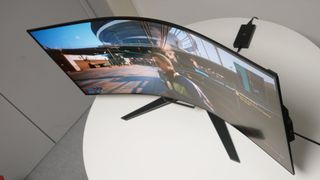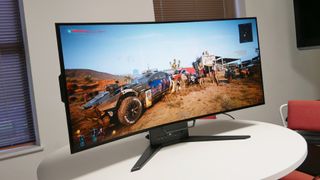12DOVE Verdict
The Corsair Xeneon Flex 45WQHD240 is a 45-inch monster with a flexible OLED panel that features epic proportions and intriguing features - but falls short through a couple of flaws and a hefty price tag.
Pros
- +
Fantastic black levels and contrast
- +
Ultra-quick pixel response
- +
Good connectivity
Cons
- -
Hugely expensive
- -
Limited brightness
- -
Relatively low resolution
Why you can trust 12DOVE
It's been a long old wait for OLED tech to make the jump from TVs to PC monitors, but it's finally happening, and the Corsair Xeneon Flex 45WQHD240 is the latest to jump on the OLED train. And it's a 45-inch monster of a gaming monitor.
OLED screen tech sourced from LG is the main attraction here. It's a 45-inch panel, which is huge for a PC monitor. It's extremely quick too, thanks to 240Hz refresh and OLED's characteristically bonkers-fast response times. With just 3,440 by 1,440 pixels, however, it's not terribly high resolution for such a large screen.
OLED tech aside, the Xeneon Flex stands apart courtesy of its novel flexible panel. You can manually adjust this screen from completely flat all the way to an extreme 800R curve. For context, the previous king of the curve, the Samsung Odyssey Neo G9, only manages 1000R. So at full flex, this monitor sets a new standard in that regard at least.
Elsewhere, there's good connectivity including USB-C with power delivery, DisplayPort, and HDMI. So, it's ready to rock with both PCs and consoles. All told, this is no thinly disguised OLED TV, which is arguably an accusation you could level at some other large form factor OLED monitors. OK, some TV-related genes remain. But Corsair has put some pretty serious engineering effort into making this a proper PC monitor. Time to find out if that work has paid off.

Design & Features
The sheer scale of the Corsair Xeneon Flex 45WQHD240 is the first thing that hits you. Sure, we've seen plenty of big monitors before, many of which are very much TV-based. The thing about the Xeneon Flex is that it combines that 45-inch diagonal with a 21:9 ultrawide aspect ratio, which isn't something you'd normally associate with a gaming TV.
Then there's the "flex" feature. Using handles on each side of the panel, you manually heave the screen to your preferred angle of bend. In all candour, the process feels a bit janky and the mechanism a little fragile. In theory, the handles are supposed to "click" when you have reached full flex, ensuring you achieve a symmetrical bend across the panel. In practice, it's all a bit hit-and-miss.
To be clear, this monitor generally looks and feels very nicely put together. But the "flex" feature itself doesn't inspire a huge amount of confidence, which might in part be a consequence of novelty. Still, the all-in-one package of an ultrawide monitor that can become a curved gaming monitor is something some folks might relish and live for.

One aspect that certainly is welcome involves the effort Corsair has made to ensure the longevity of the OLED panel. Pixel burn-in is the great fear with any OLED panel and Corsair has implemented multiple mitigations in response. That includes a full-panel resolution of 3,456 by 1,456 pixels, slightly more than the display resolution of 3,440 by 1,440, thereby allowing the image to be shifted regularly and avoid a persistent image being displayed by any pixels. All told, Corsair backs the Xeneon Flex with a three-year Zero Burn in and Zero Dead Pixel Warranty.
As for connectivity, dual HDMI 2.1 ports mean it can be deployed (resolution compromises taken into account) as a PS5 monitor or Xbox Series X monitor, while DisplayPort and USB-C will do the job for a gaming PC or gaming laptop. The latter connection supports 90W power delivery, allowing a laptop to drive the display and charge with a single cable. Four USB-A sockets are also built into the stand, two on the rear and two on the front, creating a very useful and ergonomic hub arrangement.

Performance
Corsair makes some pretty impressive performance claims for the Xeneon Flex. Along with 240Hz refresh, the OLED panel is rated at 0.03ms for grey-to-grey pixel response and 0.1ms for full on-off. No LCD-based screen even comes close to those response figures.
It's a pretty color-accurate panel too, with claimed 98.5 percent coverage of the demanding DCI-P3 digital cinema gamut, plus 96.3 percent coverage of Adobe RGB. Then there's 1.5M:1 contrast, a consequence of the pretty much perfect per-pixel lighting control of OLED technology.
However, there are a couple of slightly trickier areas of the spec sheet which impact performance, both of which arguably come with the territory in OLED land. Firstly, while Corsair rates the panel's peak brightness at a punchy 1,000nits, the detailed picture is, well, a bit more complicated.

That 1,000 nits can only be achieved in a small patch three percent patch of the screen. The panel can hit 800 nits over 10 percent of the panel, 450 nits over 25 percent, and just 150 nits full screen. Hold that thought for a moment.
The other issue is the sub-pixel layout. Typical PC monitors use an RGB or red, green, and blue subpixel payout and indeed various aspects of the Windows interface, including fonts, are rendered with that assumption in mind. The Xeneon Flex. however, uses LG's typical RWBG layout, where the 'W" indicates an additional white subpixel to boost brightness.
Long story short, it's suboptimal for general computing, especially given the big, fat pixels that result from the relatively low resolution on such a large screen. But actually in-game or watching video, it probably doesn't matter.

What does matter is the brightness problem. In darker game scenes like, say, a dingy indoor bar in Cyberpunk 2077, the Xeneon Flex looks pretty great. The neon signs behind the bar really pop, the black levels are fabulous, and there's non of the glow or halo-ing around brighter objects that you can get with mini-LED-driven LCD monitors.
On the other hand, head outside into the bright sunlight, and the screen just can't sustain those highs across the whole panel. Whether it's the aforementioned Cyberpunk, your favourite racing sim, shooter, or strategy title, the brighter the scene, the more disappointing the result. This monitor just isn't terribly punchy when rendering brighter images and scenes.
Notably, the Alienware AW3423DW, which uses Samsung rather than LG panel tech, is very definitely better when it comes to full-screen brightness. That's a pity because, in many other regards, the Xeneon Flex is pretty stellar. The scale of the 45-inch panel is obviously pretty epic. And the pixel response is to die for, and there's so little motion blur. Add in the 240Hz refresh, and this is quite the experience for playing online shooters like Apex Legends, CS: Go and Fortnite, it really is.

Overall - should you buy it?
With a few caveats, you can make a decent case for the Corsair Xeneon Flex 45WQHD240. It's huge, mostly very well-engineered, incredibly quick, and looks spectacular with the right content.
Problem is, it does have to be the right content. It only really delivers the full HDR experience with darker images contrasted by small bright objects. The Xeneon Flex's full-screen pop is disappointing. The low resolution isn't great when it comes to using this screen as a conventional monitor for general computing, either.
Then consider the fact that you can get a full 4K OLED TV for a lot less money and the Xeneon Flex's overall proposition is even harder to justify. Sure, a 40-something-inch TV will lack several features like USB-C and DisplayPort. It'll run at half the refresh, too. But it'll also cost half the money and that's impossible to ignore.
It's an intriguing monitor, the Corsair Xeneon Flex 45WQHD240. And it does some things very well indeed. But it's just too flawed and at around $2,000 / £2,100 too expensive to recommend.
How we tested the Corsair Xeneon Flex 45WQHD240
The OLED revolution has begun and with it comes a new approach to assessing image quality. OLED screens deliver per-pixel lighting and that makes judging brightness tricky. We assess brightness both with test images and real-world gaming and media consumption to uncover both the hard numbers and the actual gaming experience. We also consider all the usual metrics, including response times, latency, connectivity, and more.
You can read more about how we test gaming monitors at 12DOVE or read more about our whole approach to gaming tech in our Hardware Policy.
Want to compare the Xeneon beast to more specialist gaming TVs? Then check out the screens in our best 120Hz 4K TVs, and best TV for PS5 and Xbox Series X guides.
A serious dissertation on the finer points of input lag and overshoot followed by a forensic examination of AI-accelerated temporal upscaling. Such is a routine day in the working life of long-time tech wordsmith, Jeremy Laird. Along with GamesRadar, Jeremy’s 15-year back catalogue includes a host of tech and gaming outlets, including TechRadar and PC Gamer, not to mention contributions to mainstream media from the Independent to the Evening Standard. Complimenting Jeremy’s debilitating addiction to all kinds of digital hardware, he is also afflicted by an obsession with and a significant occupational sideline in cars and automotive technology.
Turn-based RPG Clair Obscur dev says all-star voice actor lineup includes people like Andy Serkis and Baldur’s Gate 3 alumni by accident: "He was like, 'Isn't that Clive from Final Fantasy?'"
As Marvel Rivals continues to dominate hero shooters, Overwatch 2 teases "groundbreaking PvP gameplay changes" on the way

Peach Momoko's Ultimate X-Men just revealed a surprising comic book connection to a top-tier Marvel Rivals character
